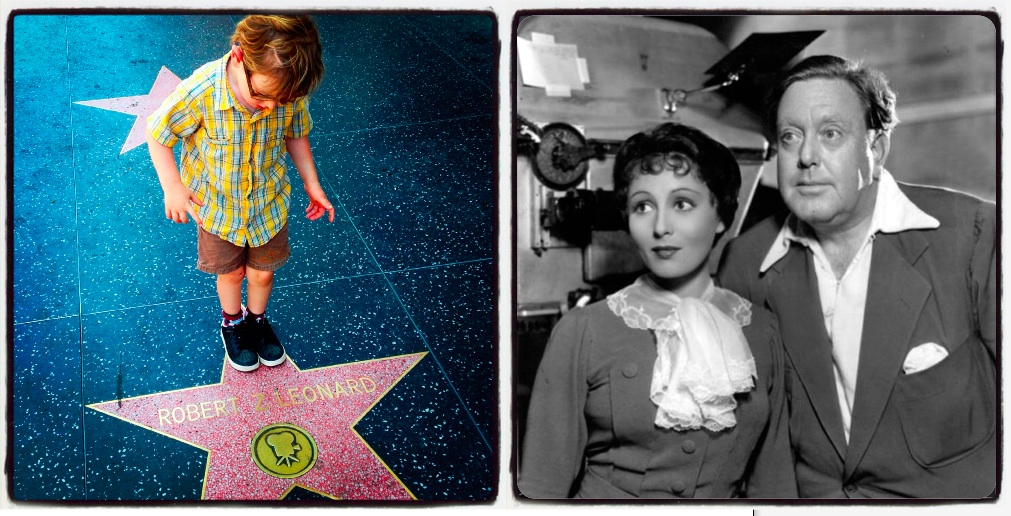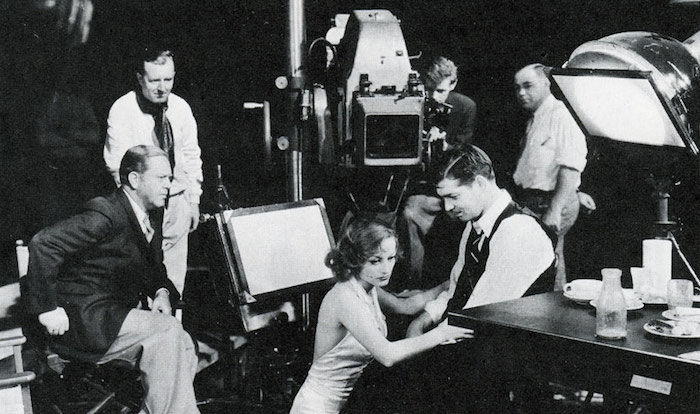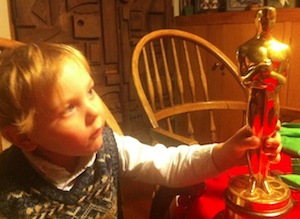 A weekly feature in which my five-year-old son is let loose on the Hollywood Walk of Fame, one of the most popular tourist attractions in Los Angeles, and chooses a star from among the more than 2,500 honorees. His “random” picks sometimes reveal unexplained connections such as the summer day in 2012 when he sat down on the star of actress Celeste Holm and refused to budge. We later learned that the Oscar-winning actress had died only hours earlier. There are five categories on the Walk of Fame: motion pictures, television, radio, music and theater but Charlie tends to favor the movies.
A weekly feature in which my five-year-old son is let loose on the Hollywood Walk of Fame, one of the most popular tourist attractions in Los Angeles, and chooses a star from among the more than 2,500 honorees. His “random” picks sometimes reveal unexplained connections such as the summer day in 2012 when he sat down on the star of actress Celeste Holm and refused to budge. We later learned that the Oscar-winning actress had died only hours earlier. There are five categories on the Walk of Fame: motion pictures, television, radio, music and theater but Charlie tends to favor the movies.
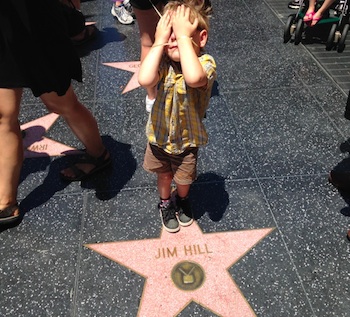 It was a very sunny day in Hollywood this week when Charlie landed on the star of retired football defensive back and sportscaster Jim Hill. Charlie could barely keep his eyes open in the blazing sun as he stood on one of his rare TV selections and even rarer sports figure honored on the Walk of Fame. Following his career with the Green Bay Packers and the San Diego Chargers, Hill became a leading sports anchor in Los Angeles. He made an appearance in the film Rocky III and several TV series and received his star on May 9, 2006. During the ceremony Mayor Villaraigosa delared it “Jim Hill Day” in Los Angeles. Hill has been a fixture on L.A.’s CBS affiliate for over 30 years and is involved in many community activities and charities.
It was a very sunny day in Hollywood this week when Charlie landed on the star of retired football defensive back and sportscaster Jim Hill. Charlie could barely keep his eyes open in the blazing sun as he stood on one of his rare TV selections and even rarer sports figure honored on the Walk of Fame. Following his career with the Green Bay Packers and the San Diego Chargers, Hill became a leading sports anchor in Los Angeles. He made an appearance in the film Rocky III and several TV series and received his star on May 9, 2006. During the ceremony Mayor Villaraigosa delared it “Jim Hill Day” in Los Angeles. Hill has been a fixture on L.A.’s CBS affiliate for over 30 years and is involved in many community activities and charities.
But, sorry, Jim, once Charlie made it to the shade, he insisted on picking another star, this time with his eyes wide open! His revised pick was more in keeping with his usual movie focus — Oscar-nominated director Robert Z. Leonard. Born in Chicago on October 7, 1889, Leonard was attending law school when he was bitten by the acting bug. He moved to Hollywood and started getting small parts in silent films. Among his many early roles was a performance as the Scarecrow in the 1910 short based on L. Frank Baum’s The Wonderful Wizard of Oz that starred Bebe Daniels as Dorothy.
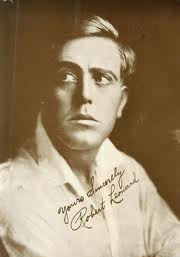 Though considered a star by 1916, Leonard always had his eye on the action behind-the-scenes and he started directing short films. At Universal, he directed a series of films starring Mae Murray, one of the first big superstars of the movies. The couple got married in 1918 and opened their own studio, Tiffany Pictures. They produced films such as The Princess from Hoboken, Mamba (which claimed to be the first full-Technicolor drama), and The Death Kiss starring Bela Lugosi which was one of the studio’s final productions. Leonard and the volatile Murray divorced in 1925 and Tiffany Pictures ceased to exist a few years after that. One sad postscript about this long-forgotten studio (other than the copyright infringement case levied against it by Tiffany & Co. jewelers!) is the fact that MGM purchased all of Tiffany’s original nitrate negatives after the studio filed for bankruptcy and then proceeded to set the entire collection aflame during the burning of Atlanta sequence in Gone With the Wind. Gulp.
Though considered a star by 1916, Leonard always had his eye on the action behind-the-scenes and he started directing short films. At Universal, he directed a series of films starring Mae Murray, one of the first big superstars of the movies. The couple got married in 1918 and opened their own studio, Tiffany Pictures. They produced films such as The Princess from Hoboken, Mamba (which claimed to be the first full-Technicolor drama), and The Death Kiss starring Bela Lugosi which was one of the studio’s final productions. Leonard and the volatile Murray divorced in 1925 and Tiffany Pictures ceased to exist a few years after that. One sad postscript about this long-forgotten studio (other than the copyright infringement case levied against it by Tiffany & Co. jewelers!) is the fact that MGM purchased all of Tiffany’s original nitrate negatives after the studio filed for bankruptcy and then proceeded to set the entire collection aflame during the burning of Atlanta sequence in Gone With the Wind. Gulp.
Robert Z. Leonard moved to MGM and became a successful director there. He corralled Joan Crawford and Clark Gable in Dancing Lady, helped Norma Shearer get a Best Actress Oscar for The Divorcée, and directed the huge MGM hit The Great Ziegfeld, which won an Oscar for actress Luise Rainer (still with us at the age of 104). Other films of note included Pride and Prejudice with Greer Garson and Laurence Olivier, Third Finger, Left Hand with Myrna Loy and Melvyn Douglas, Ziegfeld Girl with James Stewart, Judy Garland, and Hedy Lamarr, and Weekend at the Waldorf with Ginger Rogers, Lana Turner, and Walter Pidgeon. He also directed Elizabeth Taylor in Cynthia, Barbara Stanwyck in B.F.’s Daughter, and Esther Williams in Duchess of Idaho.
Leonard rarely gets the attention or acclaim enjoyed by some of his contemporaries, despite the fact that most of his films were extremely successful. His 1949 attempt at film noir, The Bribe, starring Robert Taylor, Ava Gardner, and Vincent Price, was considered a disaster at the time and called “a heap of junk that should never have been made” by producer Pandro S. Berman, but the film has won the respect of movie lovers in subsequent decades. Robert Z. Leonard retired from MGM in 1955 but then went to Italy where he directed Gina Lollobrigida in Beautiful But Dangerous and made one last film at Universal, Kelly and Me, with Van Johnson, Piper Laurie, and Martha Hyer.
Robert Z. Leonard, nicknamed “Pops” on his movie sets, married another silent movie actress after his well-publicized divorce from Mae Murray. He and Gertrude Olmstead were married on June 8, 1926, and remained together until Leonard’s death at the age of 78 on August 2, 1968.

